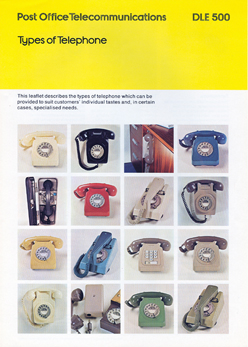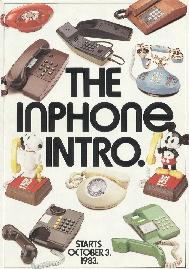 |
This section will briefly describe some of the products and services that evolved from the GPO right through to BT. It will also attempt to give an insight into the times gone by, in looking at the marketing opportunities, catch-phrases, and names of the era. Not every significant telephone is included but, others may be added later as time allows. |
Introduction to CPE
Customer Premises Equipment
For decades the sturdy black bakelite telephone was the standard offering of the GPO and Post Office Telephones. Gradually, as the company and times changed, the range and offering of telephones progressed through many rental variations, which could be recycled and repaired, to the current (purchase only) types which are cheap and disposable.
Bakelite Series
In the Fifties, black Bakelite telephones were the norm, although coloured phones such as Chinese Red, Jade Green and Ivory were available. Phones were described using the manufacturers' name and or a serial number. The 100, 200 and 300 type series were commonplace.
Modern (dial) Telephone
Following the development of an improved transmission circuit for the 300 series, a new handset was fitted to the phone which was designated the 700 type. Then, in 1959 a new plastic case was produced and the greatly improved design was known as the 706 or Modern Telephone, which was available in six colours:-
Black, Two-tone grey, Light ivory, Two-tone green, Topaz yellow, Lacquer red and Concord blue. The subscriber now had a much wider choice of colours, but still only one style!
Trimphone
In 1964 that changed when Standard Telephone & Cables (STC) went into production of the Deltaphone, which the British Post Office described as Tele. No. 712 and marketed as the:- Tone Ringing Illuminated Model Phone, better known as the Trimphone. [Click for full history]
The initial two-tone colours were; Grey-white, Grey-blue and Grey-green. Uniquely, this was the first telephone used by the BPO in which the handset is kept over the dial when not in use (rather than being at right-angles to the phone).
"For the first time in many years the Post Office is preparing for the day when it can go out and sell facilities to its telephone customers, says Mr. R Martin, Assistant Secretary in charge of the newly formed Marketing branch in the Inland Telecommunications Department." [Quote from Post Office Telecommunications Journal Summer 1965]
At that time, new telephones were developed through the British Telephone Technical Development Committee and a UK telephone manufacturer, but the Post Office was looking for new ways of evolving products to meet the needs of the growing customer market.
Compact Telephone
In 1969 the BPO (British Post Office) placed a development contract with an industrial designer, David Carter Associates. The New Style phone was produced by the BPO Factories Division and was assembled at the BPO factory in Cwmcarn, South Wales. The phone was designed to use the dial and transmission circuitry of the existing Modern Telephone. Like fashion, the design had gone full-circle because, the phone had a separate bellset. The was to keep the size of the instrument itself small enough to fit on the narrow window ledges of modern homes.Trial versions were tested in Cardiff, Canterbury and Sheffield Telephone Areas during 1973.
Quickstep Deltaphone
In 1973 STC produced a press-button version of its Deltaphone... and the era of the dial telephones began to wane.
Keyphone
A press-button phone in a 700 series case was quite an elusive phone which had appeared many years earlier, but was not ready for the market until 1975 by which time designs had moved on.
Compact (Jubilee version)
From 23 May 1977, to celebrate the Queen's Silver Jubilee, the Compact Telephone was produced for a limited period in a Jubilee Year Version, Balmoral Blue complete with royal crests.The bellset was Dove Grey with matching Heron Grey spiral cords. An added marketing feature was the choice to retain the phone if you moved home.
Special Range Telephones
Following on from the limited success of the Compact telephone, in 1978 the Post Office decided to buy-in a large variety of phones from several manufacturers. The first models were available for a premium rental which reduced after the initial 5 year term had ended. A 'front loaded' tariff was later available and combined with the choice of retaining the phone if you moved home, some customers mistakenly believed they had bought the phones outright. Early SRTs used a plug 505 together with a Jack 96A. As the modern PST plug system was introduced in 1981 later SRTs were available only to buy rather than rent.
SRT Portfolio
Astrofon, Candlestick, Classic, Contempra, Dawn, Deltaphone, Deltaphone Deluxe, Eiger, Empress, Empress Deluxe, Ericofon 600, Ericofon 700, Featurephone SL-1, Genie, Mickey Mouse, Picturephone, Rhapsody, Rhapsody Leather, Snoopy and Versatel.
Launch of the Compact Telephone
This was officially launched during the Summer of 1979 and what was originally intended as a standard replacement for the 700 series, became simply another premium telephone. The pace of change was advancing and in the same year trials of the next generation of telephone was already taking place.
New Generation Telephone
Was introduced in 1981 as a modern premium telephone for the Eighties. It was one of the first phones designed to work with the new high impedance Plug, Socket, Telephone (PST) system which paved the way for the opening up of the supply side of the market. The Ambassador was a fitting name for a complete range of models, wall brackets, amplifying handsets and matching switching systems which continued the family.
Plug, Socket and Telephone (PST)
A trial of the modern PST system, using captive line jack units, took place early in 1981 in Taunton & Carlisle. The scheme was introduced nationally for residential lines, at the end of 1981 and later on for business lines as well.
Phoenixphones
Were standard 700 style telephones and Trimphones in an exciting range of new colour combinations, which were marketed from February 1982. The name of Phoenixphones may have been used because, most of the stock was made up of refurbished items. However, such was the standard of Factories Division's work that the only imperfection in the product was (considered by some) the rather unusual choice of colours.
Handset / Body combinations were: Beige/Olive Green; Orange/Dark Orange; Red/Dark Red; Grey/Black; Mid Green/Light Green; Cream/Brown.
In line with the opening up of the extension telephone market to competition, they were for sale only, not rental. In any case the dial telephone had only a few short years left as the basic offering for rental.
IXT and the NET
Also during 1982, British Telecom introduced two new telephones which were to replace the 700 series as standard instruments:-
The IneXpensive Telephone, named the Statesman, was a private venture between TMC (Telephone Manufacturing Co.), Plessey and GEC (General Electric Co.).
And the New Electronic Telephone, the Viscount was developed by STC (Standard Telephone and Cables).
The disadvantage with the new phones was that a separate bracket was needed for wall mounting and there was often a shortage of the matching colour item.
To the enhance the 'family' of British Telecom products, the Statesman and Viscount continued on the naming theme of "Authoritative Figures." However, with so many phones now coming onto the market, it was clear that BT would need to actively promote all of its products if it was to maintain its position as the main supplier...
Spectrum Services
Were the names given to a grouping of products as part of the "Value Added Services" within the BT Enterprises division of British Telecom which was still in the early stages of 'recovering' from being "British Telecom - Part of the Post Office."
Telecom Gold: Electronic Mailbox
Telecom Silver: Credit Card Authorization
Telecom Red: Alarm Systems
Telecom Tan: Answering Service
Telecom Blue: Blue sky kind of product
Telecom Violet: Audioconferencing
Telecom Green: (Network Nine) Office Services
The "Value Added Services" began to give an impression of solutions for the business customer rather than just another range of products, but British Telecom also needed to keep 'in' with the residential customer as well...
Inphone Intro
 |
On October 3rd 1983, British Telecom launched the INPHONE campaign, which was a whole new concept in advertising the phone. INPHONE was much more than simply a marketing strategy, it was designed to give the company a complete brand identity. The new plug and socket system of connecting phones had just been introduced in 1981 and the catchy little slogan; INTOUCH. INTONE. INPHONE was an excellent attempt to promote a complete range of phones. |
The new British Telecom quickly needed to show it was serious about supplying telephones and switching systems to the business communities and the Merlin brand name of products was launched during 1982.
Loss of PIM
BT lost its Prime Instrument Monopoly on 1st January 1985, from when customers were no longer obliged to rent a phone.
Tribune Telephone
Was introduced in 1986 as the replacement for the 700 series dial telephone. It was developed exclusively for BT and filled a much needed gap in the market, as the 746 dial telephone was being phased out, but no other phone, apart from the Ambassador, could be supplied with an amplifying handset and of course the Ambassador was quickly becoming outdated itself.
Lettered Dials (Keypads)
On 24th February 1992, British Telecom launched an updated family of basic and premium phones, the Relate, Converse and Duet. These press-button phones were the first in many years to have the keypads marked with numbers and letters, in preparation for the re-introduction of dialling by name, rather than number. Both the Relate and Converse had the option of wall-mounting without the need for any additional brackets and sensibly the screws and wall fixings were also supplied.
Synopsis
With hindsight, the majority of the phones took far too long to develop in what was a rapidly evolving market with new legislation and customer trends changing all too quickly..
Brand Names
Since the Ambassador telephone was launched in 1981, BT has continued a policy of naming its products along the lines of families. Some of the groups contain mixed products, e.g. telephones and telex machines.
Authoritative Figures:
Telephones: Ambassador, Empress, Genie, Sceptre, Statesman, Tribune, Vanguard, Viscount.
Call Connect Systems/Terminals: Ambassador, Cadet, Consort, Ensign, Escort, Herald, Kinsman, Marquis, Merlin, Monarch, Navigator, Orator, Regent, Senator, Viceroy.
Note: Merlin was a brand name for a whole range of services.
Wildlife and Rivers
Answering Machines, Phones, Telex & Services: Cheetah, Curlew, Eagle, Falcon, Hawk, Kingfisher, Leopard, Osprey, Piglet, Puma, Robin, Sable, Seadog, Talon, Tern, Tigger, Wren.
Callmakers & Services: Medway, Solent, Trent, Tyne.
Precious Metals and Gems
Radiophone Services:
Telecom Amber, Telecom Amethyst, Telecom Bronze, Telecom Cobalt, Telecom Coral, Telecom Emerald, Telecom Jade, Telecom Jet, Telecom Opal, Telecom Pearl, Telecom Quartz, Telecom Ruby, Telecom Sapphire, Telecom Steel, Telecom Topaz.
People and Emotions
Telephones & Answering Machines:
Converse, Diverse, Duet, Rapport, React, Relate, Response, Synergy
Update
There's a whole range of phones after these to bring the story up to date. As of 2015 I assume that customers ordering new lines will buy phones, though apparently the BT Converse 2200 can still be rented. As for hard-wired lines and phones without sockets, perhaps some still exist?
All logos and trade marks are the property of their respective owners and are used on the Light Straw site(s) for review only. Students and researchers are recommended to make their own independent enquiries as to the accuracy of the information contained therein.